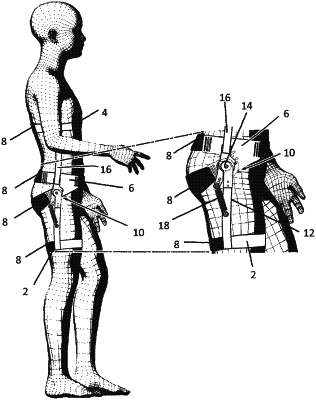| CPC A61F 5/028 (2013.01) [A61F 5/0104 (2013.01); A61H 1/0292 (2013.01); B25J 9/0006 (2013.01); A61F 5/024 (2013.01); A61F 2005/016 (2013.01); A61F 2005/0155 (2013.01); A61F 2005/0162 (2013.01); A61F 2005/0179 (2013.01); A61F 2005/0197 (2013.01); A61H 2201/1238 (2013.01); A61H 2201/163 (2013.01); A61H 2201/1642 (2013.01); A61H 2201/1673 (2013.01); A61H 2205/081 (2013.01)] | 19 Claims |

|
1. An orthopedic device for supporting a lower back of a user, wherein the device comprises:
an energy store,
a pelvic element,
an upper body element with a first force transmission element, and
an upper leg element with a second force transmission element,
wherein
the upper leg element is arranged on the pelvic element such that the upper leg element is swivelled about a first swivel axis,
the upper body element is movably arranged relative to the pelvic,
the first force transmission element is engaged and disengaged with the second force transmission element by moving the upper body element relative to the pelvic element, and the energy store is discharged by swivelling the upper leg element relative to the upper body element when the first force transmission element is engaged with the second force transmission element, wherein, in an active state, the first force transmission element and the second force transmission element are automatically engaged or disengaged by moving the upper body element relative to the pelvic element, and wherein, in a passive state, the first force transmission element and the second force transmission element are not automatically engaged or disengaged by moving the upper body element relative to the pelvic element.
|